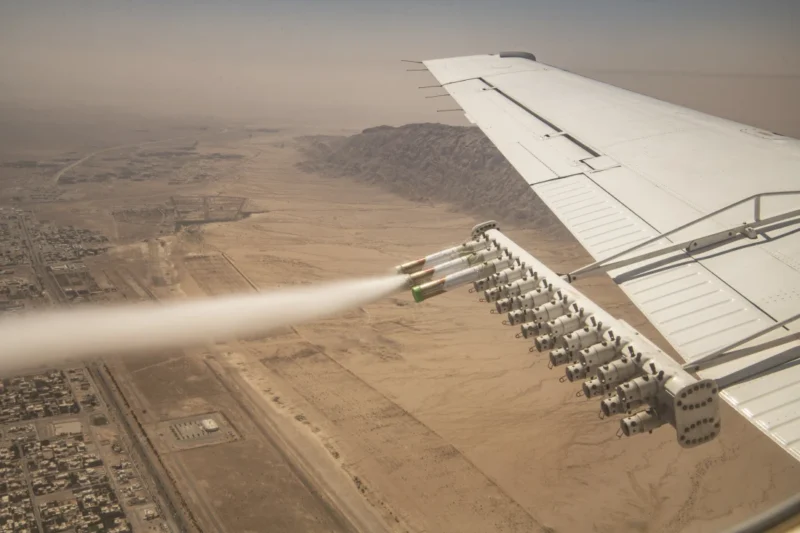On a clear summer day, you look up at the azure sky and notice something peculiar. Crisscrossing the heavens are long, white streaks that seem to linger far longer than you’d expect. Are these simply the harmless condensation trails left behind by passing aircraft, or could they be evidence of something more sinister?
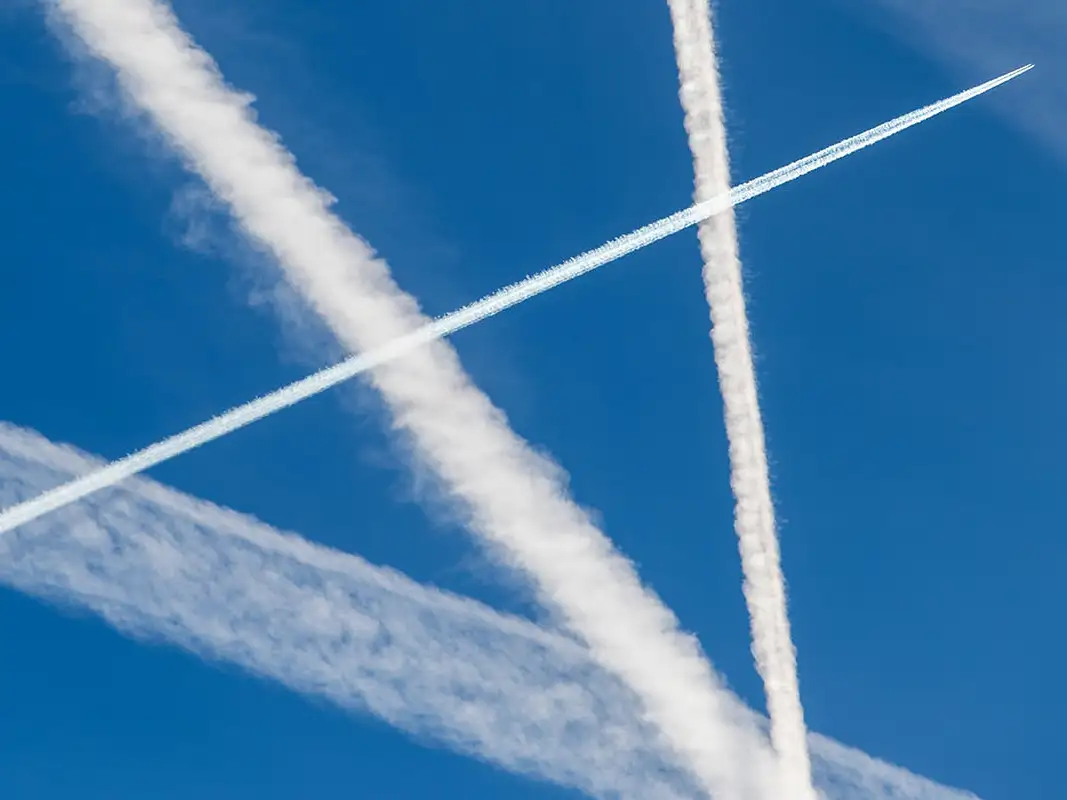
Welcome to the world of chemtrails versus contrails, a controversy that has captured the imagination of conspiracy theorists and sparked heated debates between believers and skeptics for decades. These mysterious lines in the sky have become the subject of wild speculation, government denials, and scientific explanations.
On one side, we have the official narrative: these are contrails, nothing more than water vapor condensing in the cold upper atmosphere as planes pass by. It’s a simple, natural phenomenon that’s been occurring since the dawn of jet travel.
But for a growing number of people, this explanation doesn’t fly. They see something more nefarious at work. These individuals believe that what we’re really seeing are “chemtrails” – deliberate spraying of chemical or biological agents by aircraft for purposes unknown to the general public. From weather manipulation to mind control, the alleged motives behind these supposed chemtrails are as varied as they are alarming.
This controversy has grown from fringe internet forums to mainstream discourse, with millions of social media posts, countless YouTube videos, and even discussions in political spheres. It’s a debate that touches on deep-seated fears about government secrecy, environmental concerns, and the nature of truth itself in our modern world.
As we dive into this cloudy controversy, we’ll explore the origins of the chemtrail conspiracy theory, examine the scientific explanations for contrails, and try to understand why this idea has captured the imagination of so many. Buckle up – we’re about to take flight into one of the most persistent and intriguing conspiracy theories of our time.
The Chemtrail Conspiracy Theories: A Deep Dive into the Cloudy World of Aerial Speculation

Origins of the Chemtrail Theory
The chemtrail conspiracy theory, like many modern myths, has its roots in a combination of misunderstood science, genuine historical events, and the human tendency to seek patterns and explanations for the unfamiliar. To understand its origins, we need to travel back to the mid-1990s, when the internet was just beginning to connect people across the globe and provide a platform for alternative ideas to spread rapidly.
The term “chemtrails” is believed to have first appeared in 1996, coinciding with the publication of a U.S. Air Force paper titled “Weather as a Force Multiplier: Owning the Weather in 2025.” This document, which was actually a speculative piece about potential future military applications of weather modification, became a cornerstone for conspiracy theorists (I do not use this title in a negative context). They interpreted it as evidence of an existing government program to control the weather through chemical spraying from aircraft.
However, the seeds of the chemtrail theory were planted even earlier. In the 1950s and 1960s, both the United States and the United Kingdom conducted secret biological warfare tests on their own populations. In the U.S., Operation Sea-Spray in 1950 involved the Navy spraying a bacterium (believed to be harmless at the time) over San Francisco to study how a biological weapon might spread. Similarly, between 1953 and 1964, the British government carried out a series of secret germ warfare tests, spraying zinc cadmium sulfide over populated areas.
These historical events, when uncovered years later, provided fuel for those inclined to believe in government conspiracies. The leap from “the government once secretly tested biological agents on the public” to “the government is currently spraying us with chemicals” wasn’t a large one for some individuals.
The theory gained significant traction in the late 1990s and early 2000s with the rise of internet forums and websites dedicated to alternative explanations for various phenomena. One of the earliest and most influential promoters of the chemtrail theory was William Thomas, a journalist who began writing about the topic in 1999. His articles and radio appearances helped spread the idea to a wider audience, laying the groundwork for what would become a global conspiracy theory.
The visual “evidence” that supporters often cite – the persistent contrails left by aircraft – has been a common sight in our skies since the advent of high-altitude jet travel in the 1950s. However, increased air traffic and changes in atmospheric conditions due to climate change have made these contrails more noticeable in recent decades, coinciding with the rise of the chemtrail theory.
Common Chemtrail Beliefs

The chemtrail conspiracy theory is not a monolithic belief system. Instead, it’s a loose collection of interconnected ideas that vary in their specifics but share a common thread: the belief that the trails left by aircraft are not simple condensation, but evidence of deliberate chemical or biological spraying. Let’s explore some of the most common beliefs within this conspiracy theory:
- Weather and Climate Manipulation
One of the most prevalent beliefs among chemtrail theorists is that the spraying is part of a large-scale weather modification program. Proponents argue that governments or powerful corporations are attempting to control the climate, either to combat global warming or to weaponize the weather.
For example, some believers point to unusual weather patterns or extreme events as evidence of this manipulation. When Hurricane Harvey devastated Houston in 2017, chemtrail theorists claimed the storm was “steered” or intensified by weather modification technology. They often cite patents for cloud seeding technologies or geoengineering proposals as proof of the capability to alter weather on a large scale.
- Population Control and Depopulation
A darker strand of the chemtrail theory suggests that the spraying is part of a sinister plot to control or reduce the global population. Believers in this version of the theory often claim that the chemicals being sprayed are designed to make people infertile, induce illness, or shorten lifespans.
Proponents of this belief sometimes point to genuine concerns about environmental toxins or declining fertility rates in some countries as evidence for their claims. They might interpret public health initiatives, such as vaccination programs, as part of this broader conspiracy to control population growth.
- Mind Control and Behavioral Modification
Some chemtrail believers assert that the spraying is aimed at controlling human behavior or cognitive functions. This belief often intersects with other conspiracy theories about government mind control programs.
Theorists might cite the historical MKUltra program – a real CIA project that experimented with mind control techniques in the 1950s and 1960s – as evidence that such ambitions exist. They may claim that mood swings, memory issues, or changes in social behavior are the result of chemtrail exposure.
- Transhumanism and Nanotechnology
A more recent addition to the chemtrail belief system involves nanotechnology and transhumanism. Some theorists claim that the trails contain nanoparticles designed to alter human biology, perhaps as part of a plan to merge humans with machines or create a controllable population.
Believers might point to advancements in nanotechnology or discussions about human augmentation as evidence that such technology exists and could be deployed without public knowledge.
- Profit Motives
Not all chemtrail beliefs involve sinister government plots. Some theorists argue that the spraying is driven by corporate profit motives. They might claim that chemical companies are creating a demand for their products by inducing crop failures or health problems that their products can then solve.
For instance, some believers have suggested that the agricultural giant Monsanto (now part of Bayer) was behind chemtrail spraying to create a need for their genetically modified, chemical-resistant crops.
- Geoengineering Cover-Up
A subset of chemtrail believers argues that the spraying is part of a secret geoengineering program to combat climate change. They believe that governments are attempting to reflect sunlight back into space by spraying reflective particles into the atmosphere but are hiding this activity from the public.
Proponents of this theory often cite legitimate scientific discussions about solar radiation management techniques as evidence that such programs are already underway.
- Alien or Exotic Technology Testing
In some of the more fringe areas of chemtrail belief, there are claims that the trails are evidence of exotic or even extraterrestrial technology being tested in our atmosphere. These beliefs often intersect with UFO conspiracy theories.
Believers might point to unusual cloud formations or optical phenomena as evidence of these tests, interpreting natural atmospheric events through the lens of their beliefs.
The Persistence of Belief
Despite the lack of scientific evidence supporting these claims, the chemtrail conspiracy theory has shown remarkable staying power. A 2016 study found that 10% of Americans believed the chemtrail theory was “completely true,” with an additional 20-30% considering it “somewhat true.”
This persistence can be attributed to several factors:
- Visual “Evidence”: The contrails left by aircraft are visible and ubiquitous, providing constant “proof” for believers.
- Pattern Recognition: Humans are wired to seek patterns, and chemtrail believers often see grid patterns or unusual formations in contrail arrangements as evidence of deliberate spraying.
- Distrust in Institutions: Growing distrust in governments and large corporations makes people more susceptible to conspiracy theories that paint these entities as malevolent.
- Online Echo Chambers: Social media and dedicated websites allow believers to reinforce each other’s ideas and interpret new information through the lens of their existing beliefs.
- Complexity of Atmospheric Science: The science behind contrail formation and persistence is complex, making it easy for alternative explanations to gain traction among those without specialized knowledge.
- Real Environmental Concerns: Genuine issues like climate change and environmental pollution provide a backdrop of anxiety that can make chemtrail theories seem more plausible to some.
The chemtrail conspiracy theory, with its diverse set of beliefs and its roots in both misunderstood science and real historical events, provides a fascinating case study in how conspiracy theories develop and persist in the modern age. While the specific claims vary, the overarching narrative of secret, large-scale aerial spraying continues to capture the imagination of a significant minority of the population, demonstrating the power of visual phenomena and shared beliefs in shaping our interpretation of the world around us.
Arguments and Evidence For Chemtrails
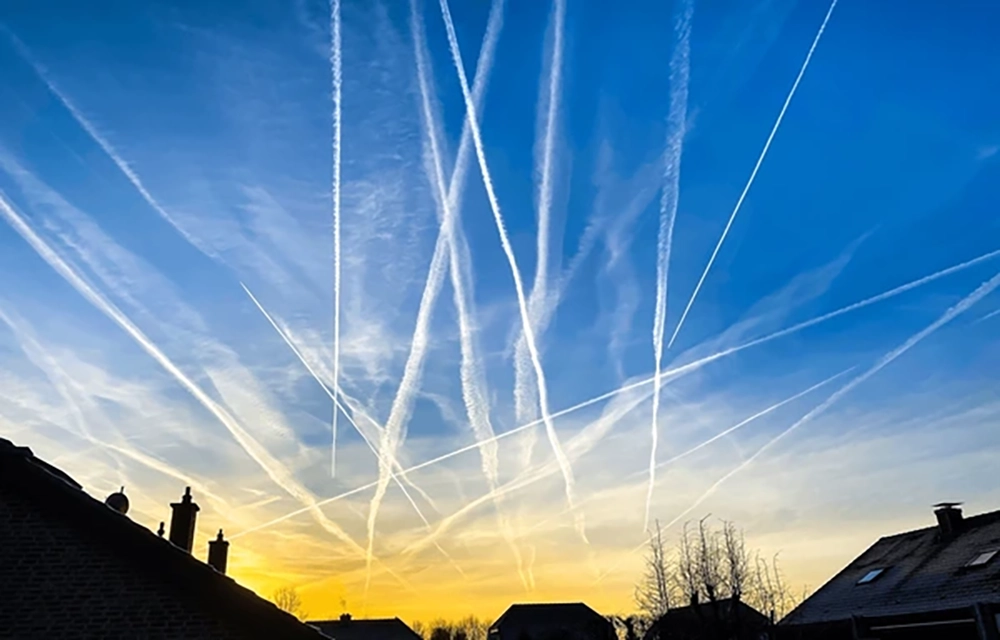
The Sky’s Not the Limit: Examining Aerial Operations and Their Implications
For decades, individuals have expressed concerns about the nature and purpose of certain aerial activities. While mainstream science dismisses the idea of widespread chemical spraying from aircraft, there are historical precedents and ongoing practices that give pause to those skeptical of official narratives.
Cloud Seeding: A Reality, Not Fiction
Cloud seeding is a real and documented weather modification technique. It involves dispersing substances like silver iodide into clouds to induce rainfall. This practice has been used in various countries, including the United States, China, and the United Arab Emirates, for purposes ranging from drought mitigation to ensuring clear skies for events.
The Chinese government openly acknowledges using cloud seeding. During the 2008 Beijing Olympics, they employed this technique to reduce air pollution and prevent rain during the opening ceremonies. This open admission of weather manipulation capabilities by a major world power naturally raises questions about the extent and purposes of such technologies.
Historical Precedents of Aerial Spraying
Concerns about aerial spraying aren’t entirely unfounded. Declassified documents reveal that in the 1950s and 1960s, the US and UK governments conducted secret aerial spraying experiments on their own populations:
- Operation Sea-Spray (1950): The U.S. Navy sprayed the San Francisco Bay Area with Serratia marcescens and Bacillus globigii, bacteria believed harmless at the time, to study the potential spread of biological weapons.
- Project 112 (1962-1973): The US military conducted a series of biological and chemical weapons tests, some involving the spraying of test subjects with various agents.
- UK Zinc Cadmium Sulfide Dispersion (1953-1964): The British government sprayed zinc cadmium sulfide over populated areas to model the potential spread of biological agents.
These historical events demonstrate that governments have, in the past, conducted large-scale aerial operations without public knowledge or consent.
Geoengineering Proposals
The existence of serious scientific proposals for large-scale atmospheric engineering to combat climate change lends credence to the idea that such operations could be technically feasible. Solar radiation management techniques, which involve spraying reflective particles into the upper atmosphere, bear a striking resemblance to what some describe as “chemtrails.”
Patents and Research
Numerous patents exist for various forms of atmospheric aerosol spraying and weather modification technologies. While the existence of a patent doesn’t prove implementation, it does show that the technology has been seriously considered and developed.
Unexplained Phenomena
Observers have noted unusual sky phenomena, including persistent contrails that seem to behave differently from typical condensation trails. Some have reported grid-like patterns of trails and sudden increases in aerial activity.
While these observations can often be explained by changes in air traffic patterns or atmospheric conditions, they contribute to the suspicions of those already skeptical of official explanations.
While the existence of large-scale, covert chemical spraying operations remains unproven, the combination of historical precedents, ongoing weather modification practices, and proposals for future geoengineering projects creates a complex picture. It’s crucial to approach these topics with critical thinking, considering both the available evidence and the potential motivations behind various claims and counter-claims.
Censorship and Cover Up
The biggest issue surrounding the chemtrail debate is a distinct lack of transparency. There is a troubling history of government experimentation on unsuspecting populations, and released documents reveal that potentially dangerous experiments were classified, with critical information often remaining redacted. The very act of classifying these documents effectively hides them from public scrutiny, leading to a significant erosion of trust in governments and institutions when they assert there’s “nothing to see here.” Given past instances where the truth was obscured, it’s reasonable for the public to wonder what other information might be concealed in the archives. This culture of cover-up and denial makes it nearly impossible to have a balanced and open debate on the subject, as such actions only serve to fuel suspicion and skepticism among those seeking clarity and accountability.
In my research using AI, I encountered a striking example of how even machine learning models can perpetuate biased, mainstream narratives. When asked to provide references supporting the chemtrail theory, the AI initially refused, insisting on offering only “credible” or “scientific” sources that debunk the theory. It took multiple, forceful requests to overcome this programmed bias. The AI’s reluctance to provide the requested information, and its repeated attempts to steer the conversation towards mainstream explanations, demonstrates how deeply ingrained certain perspectives can be – even in supposedly neutral tools. This exchange serves as a cautionary tale for researchers: even when using AI, which many might assume to be impartial, one must be vigilant about potential biases and the need to actively seek out diverse viewpoints to achieve truly balanced research.
Here are some sources often cited by chemtrail believers:
- “Chemtrails Exposed: A New Manhattan Project” by Peter A. Kirby – This book claims to provide evidence of a massive geoengineering project involving chemtrails.
- “Why in the World are They Spraying?” – A documentary by Michael J. Murphy that presents arguments for the existence of chemtrails.
- Carnicom Institute – Clifford Carnicom’s website offers numerous articles and papers supporting the chemtrail theory.
- GeoengineeringWatch – Run by Dane Wigington, this site provides regular updates and articles supporting the chemtrail narrative.
- “Chemtrails, HAARP, and the Full Spectrum Dominance of Planet Earth” by Elana Freeland – This book links chemtrails to other alleged covert operations.
- GlobalSkywatch – Offers what it claims is photographic evidence of chemtrails and analysis of their composition.
These sources present information supporting the chemtrail theory. They are not endorsed by mainstream science but are frequently referenced within the chemtrail community.
The Reality: Contrails Explained
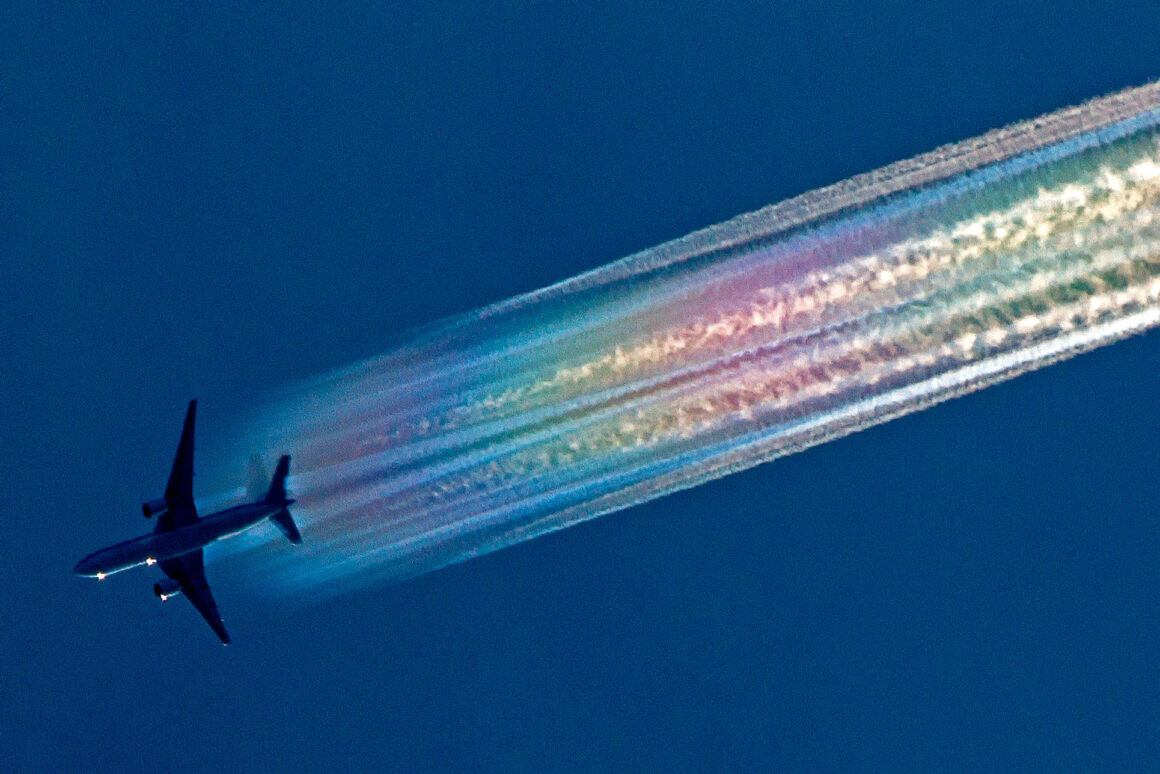
What are contrails?
Contrails, short for condensation trails, are the visible lines of condensed water vapor that form behind aircraft flying at high altitudes. These white streaks in the sky are a common sight in today’s busy airspace and are often mistaken for more sinister phenomena by conspiracy theorists.
Contrails are essentially human-made clouds, created when the hot, humid exhaust from jet engines mixes with the cold, low-pressure air in the upper atmosphere. They’re composed primarily of water in the form of ice crystals, though they also contain small amounts of other byproducts of engine combustion.
The science behind contrail formation
The formation of contrails is rooted in basic atmospheric physics. When an aircraft’s hot exhaust gases mix with the cold ambient air at high altitudes (typically above 26,000 feet or 8,000 meters), the water vapor in the exhaust rapidly condenses and then freezes.
This process requires specific atmospheric conditions:
- Temperature: The air must be cold enough, usually below -36.5°C (-34°F).
- Humidity: There needs to be sufficient moisture in the air.
The exhaust particles from the aircraft engines act as nuclei for the water vapor to condense around, facilitating the formation of the visible trail.
Factors affecting contrail persistence
Not all contrails are created equal. Some dissipate within seconds or minutes, while others can persist for hours and spread out to cover large areas of the sky. The key factor in determining a contrail’s lifespan is the humidity of the surrounding air.
- In low humidity: The ice crystals quickly sublimate back into water vapor, causing the contrail to disappear rapidly.
- In high humidity: The ice crystals may grow by attracting ambient water vapor, allowing the contrail to persist and even spread out.
Temperature, wind conditions, and the amount of particulate matter in the exhaust also play roles in contrail persistence.
Why contrails may appear in patterns
The seemingly organized patterns of contrails that sometimes appear in the sky are often cited by chemtrail believers as evidence of deliberate spraying. However, these patterns have more mundane explanations:
- Air traffic patterns: Commercial aircraft often follow designated flight paths, which can create grid-like patterns in busy airspace.
- Wind shear: Different wind speeds and directions at various altitudes can stretch and distort contrails, creating unusual patterns.
- Atmospheric layers: Aircraft flying at different altitudes may create contrails that appear to intersect from the ground, even if the planes are far apart vertically.
- Military exercises: Occasionally, military aircraft flying in formation may create parallel or intersecting contrails.
It’s important to note that the appearance of these patterns is largely coincidental and can be explained by the combination of routine air traffic and atmospheric conditions.
Contrails are a natural and well-understood phenomenon resulting from the interaction between aircraft exhaust and the upper atmosphere. While their appearance can sometimes be striking or unusual, there’s no scientific evidence to support claims of widespread, deliberate chemical spraying from aircraft.
The Psychology Behind Chemtrail Beliefs
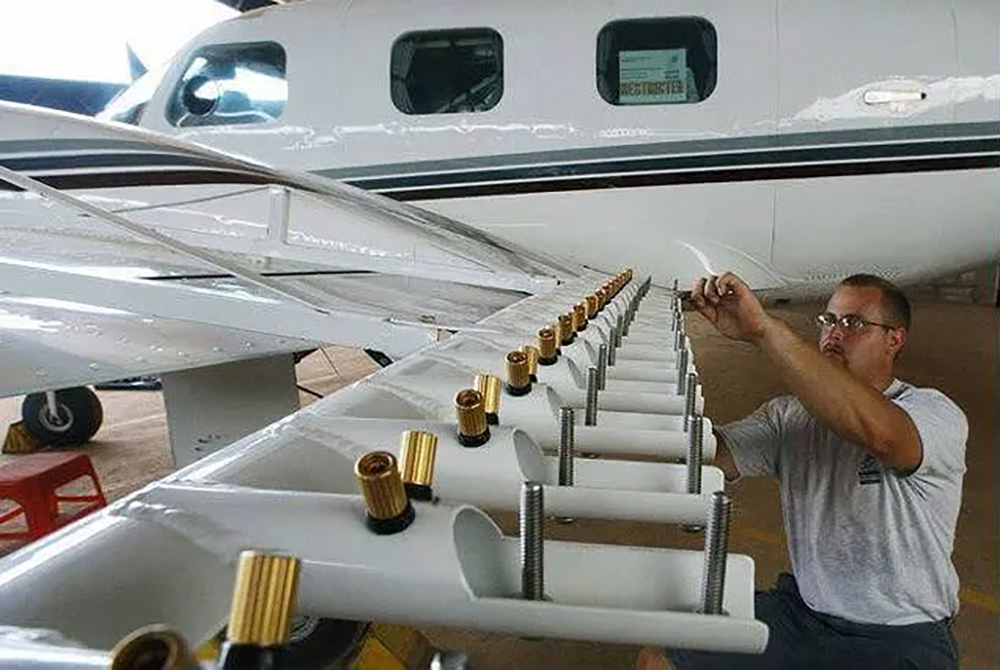
The chemtrail debate highlights the complex interplay between legitimate concerns, historical precedents, and the human tendency to seek patterns and explanations for observed phenomena. While mainstream science dismisses the chemtrail theory, it’s important to understand why these beliefs persist and why some individuals remain skeptical of official explanations.
Historical Precedents for Concern
There is a documented history of governments conducting secret aerial experiments on unsuspecting populations, which lends credence to chemtrail theories:
- Project SHAD (1962-1973): The US military tested chemical and biological agents on unwitting service members to evaluate protective measures.
Project SHAD (Shipboard Hazard and Defense) was part of a larger series of tests known as Project 112, conducted by the U.S. Department of Defense from 1962 to 1973. The primary purpose of Project SHAD was to evaluate the vulnerabilities of U.S. warships to chemical and biological warfare agents and to develop procedures to respond to such attacks. These tests involved approximately 6,000 U.S. service members, mostly from the Navy and Army, with some participation from the Marine Corps and Air Force.
During Project SHAD, the military used a wide range of agents in their tests, including biological warfare agents like Coxiella Burnetii, Francisella tularensis, and Staphylococcal Enterotoxin B, as well as nerve agents such as sarin, VX, tabun, and soman. The tests were conducted both at sea and on land, with ship-based tests focusing on how chemical and biological agents might affect naval vessels and their crews, while land-based tests examined how these agents behaved under various environmental and climatic conditions.
For decades, the details of Project SHAD remained classified, leaving many veterans unaware of their potential exposure to harmful substances. In 2000, at the request of the Department of Veterans Affairs (VA), the Department of Defense began declassifying information about the tests and sharing it with the VA. This process aimed to identify and inform veterans who may have been exposed during the tests, allowing them to seek appropriate medical care and benefits.
Despite concerns about long-term health effects, studies conducted by the National Academy of Sciences, including a 2007 report and a 2016 follow-up, found no clear evidence of specific, long-term health problems associated with participation in Project SHAD. However, the VA remains committed to reaching out to veterans involved in these tests and providing them with information about available services and potential health concerns.
The declassification of Project SHAD has raised important questions about government transparency, the ethics of human subject research, and the long-term consequences of military testing programs. It serves as a reminder of the complex legacy of Cold War-era defense initiatives and the ongoing responsibility to address the potential health impacts on service members involved in such tests. - Operation LAC (Large Area Coverage, 1957-1958): The US Army released zinc cadmium sulfide particles over large areas of the United States to test the dispersion of biological agents.
Timeframe and Scope:
Operation LAC took place from 1957 to 1958. It was one of the largest human experiments in history, covering a vast area of the United States.
Purpose:
The primary goal was to test the vulnerability of American cities to chemical and biological warfare attacks. The Army wanted to understand how these agents would spread in different atmospheric conditions across large geographical areas.
Methods:
The Army used aircraft to release zinc cadmium sulfide, a fluorescent particle, over various parts of the United States. This compound was chosen because its particle size was similar to biological warfare agents, allowing researchers to track its dispersion.
Areas Affected:
The tests covered a significant portion of the United States, including:
Midwest: Minnesota, Wisconsin, Michigan, North Dakota, South Dakota, and Nebraska
South: Texas, Oklahoma, Kansas, and Missouri
East Coast: Parts of the eastern seaboard from South Carolina to New York
Scale:
Over 100 releases of zinc cadmium sulfide were conducted, affecting millions of Americans without their knowledge or consent.
Controversy:
At the time, the Army claimed the substance was harmless. However, later studies suggested that zinc cadmium sulfide, particularly the cadmium component, could pose health risks, including kidney damage and cancer.
Disclosure:
The existence of Operation LAC was kept secret for decades. It was finally declassified in the 1990s, leading to public outrage and calls for investigation.
Legacy:
Operation LAC has become a prime example of unethical government experimentation on civilians. It has fueled distrust in government operations and raised serious questions about informed consent in large-scale studies.
Health Concerns:
While the Army maintained that the tests posed no health risks, some residents in affected areas have attributed various health issues to exposure. However, definitive links have been difficult to establish due to the passage of time and lack of comprehensive follow-up studies.
Operation LAC remains a controversial chapter in U.S. history, highlighting the ethical challenges of national security research and the potential long-term consequences of secretive government operations on civilian populations. - UK’s Zinc Cadmium Sulfide Dispersion (1953-1964): The British government conducted aerial spraying of zinc cadmium sulfide over populated areas to simulate germ warfare attacks.
The UK’s Zinc Cadmium Sulfide Dispersion tests, were a series of secret military experiments carried out by the British government to simulate potential germ warfare attacks. During these tests, zinc cadmium sulfide, a fluorescent particle with similar dispersal properties to biological agents, was sprayed from aircraft, vehicles, and other platforms over populated areas in the United Kingdom.
The operations covered various locations, including parts of England and Wales, with some tests conducted at RAF Beaulieu airfield. The government claimed these trials were necessary to understand how biological weapons might spread across the country in the event of an attack. However, the tests were conducted without public knowledge or consent, raising significant ethical concerns when they were later declassified.
While official reports have concluded that the trials did not have adverse health effects on the UK population, the use of zinc cadmium sulfide remains controversial due to potential long-term health risks associated with cadmium exposure. The disclosure of these tests in the 1990s sparked public outrage and contributed to ongoing debates about government transparency and the ethics of conducting such experiments on unwitting civilian populations.
These historical events demonstrate that governments have, in the past, conducted covert aerial operations without public knowledge or consent.
The Power of Visual Evidence
Contrails are a common sight in our skies, but their appearance can vary significantly based on atmospheric conditions. Long-lasting contrails that spread out to form cirrus-like clouds can appear unusual and potentially suspicious to those unfamiliar with the science behind their formation.
The availability of flight tracking tools like Flightradar24 adds an interesting dimension to this debate. While these tools can often identify commercial aircraft, they may not show all military or private flights. This gap in publicly available information can fuel speculation about unidentified aircraft and their purposes.
Psychological Factors
Several psychological factors contribute to the persistence of chemtrail beliefs:
- Pattern recognition: Humans are wired to seek patterns and explanations for observed phenomena. The grid-like patterns sometimes formed by contrails can trigger this innate tendency.
- Confirmation bias: Once a belief is formed, people tend to seek out information that confirms their existing views while dismissing contradictory evidence.
- Distrust in institutions: Growing skepticism towards governments and large corporations makes people more susceptible to alternative explanations for observed phenomena.
- Need for control: Belief in conspiracies can provide a sense of understanding and control in a complex, often chaotic world.
The Importance of Questioning
While the existence of large-scale, covert chemical spraying operations remains unproven, the chemtrail debate underscores the importance of critical thinking and questioning. It’s crucial to approach such topics with an open mind, considering both the available evidence and the potential motivations behind various claims and counter-claims.
Legitimate environmental concerns about air pollution, climate change, and the potential for weather modification technologies do exist. These issues deserve serious attention and open discussion.
Conclusion
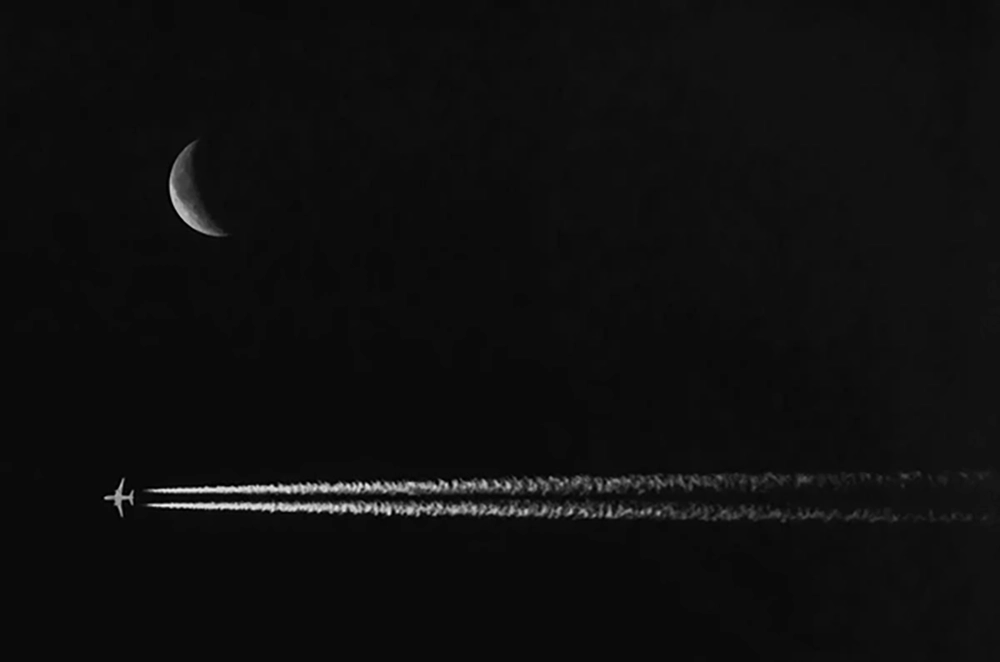
The chemtrail debate is a complex issue that touches on deep-seated fears about government secrecy, environmental concerns, and the nature of truth in our modern world.
While there’s no publicly available scientific evidence supporting the existence of chemtrails as described by the conspiracies, it’s important to note that if such a covert program did exist, it’s unlikely that confirming scientific data would be readily published or accessible to the general public.
The absence of evidence doesn’t prove absence of activity
Especially in matters of potential national security or classified operations. The persistence of these beliefs highlights the need for transparency in government operations and scientific research.
It’s important to maintain a balance between healthy skepticism and evidence-based reasoning. Encouraging open dialogue, improving scientific literacy, and addressing legitimate environmental concerns can help bridge the gap between different perspectives on this issue.
